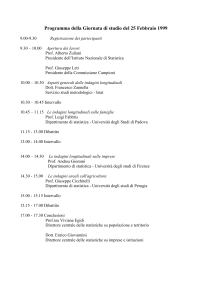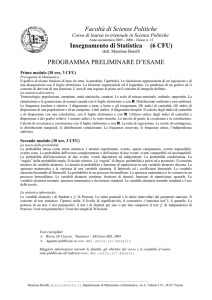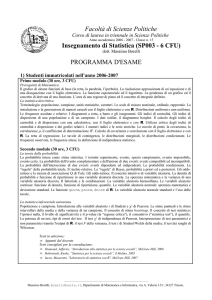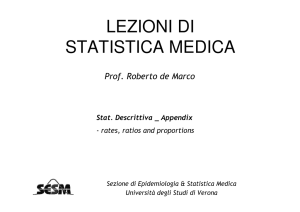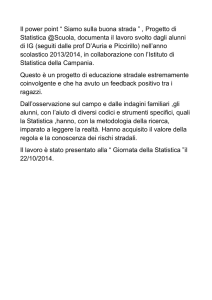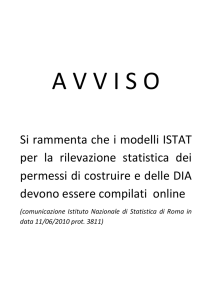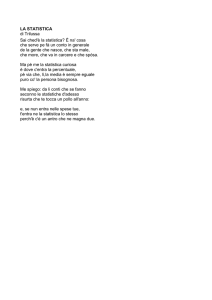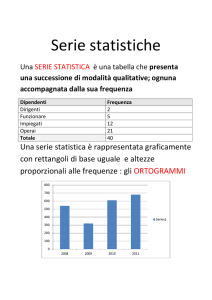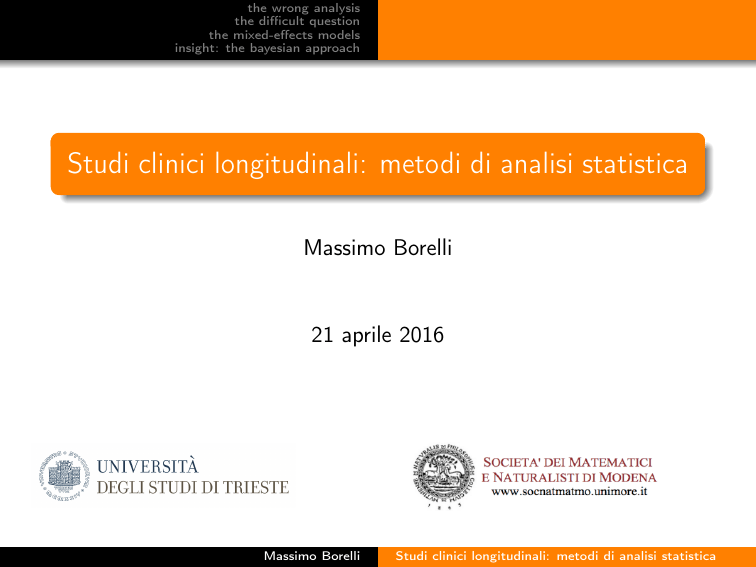
the wrong analysis
the difficult question
the mixed-effects models
insight: the bayesian approach
Studi clinici longitudinali: metodi di analisi statistica
Massimo Borelli
21 aprile 2016
Massimo Borelli
Studi clinici longitudinali: metodi di analisi statistica
the wrong analysis
the difficult question
the mixed-effects models
insight: the bayesian approach
2005, John Ioannidis
Massimo Borelli
Studi clinici longitudinali: metodi di analisi statistica
the wrong analysis
the difficult question
the mixed-effects models
insight: the bayesian approach
It is simply no longer possible to believe
much of the clinical research that is
published, or to rely on the judgment of
trusted physicians or authoritative
medical guidelines. I take no pleasure
in this conclusion, which I reached
slowly and reluctantly over my two
decades as an editor of The New
England Journal of Medicine.
2009, Marcia Angell
Massimo Borelli
Studi clinici longitudinali: metodi di analisi statistica
the wrong analysis
the difficult question
the mixed-effects models
insight: the bayesian approach
2015, Richard Horton
The case against science is
straightforward: much of the scientific
literature, perhaps half, may simply be
untrue. Afflicted by studies with small
sample sizes, tiny effects, invalid
exploratory analyses, and flagrant
conflicts of interest, together with an
obsession for pursuing fashionable
trends of dubious importance, science
has taken a turn towards darkness.
Massimo Borelli
Studi clinici longitudinali: metodi di analisi statistica
the wrong analysis
the difficult question
the mixed-effects models
insight: the bayesian approach
2016, Ron Wasserstein
Massimo Borelli
Studi clinici longitudinali: metodi di analisi statistica
the wrong analysis
the difficult question
the mixed-effects models
insight: the bayesian approach
what does it mean ’longitudinal’ ?
0 2 4 6 8 1012
PaO2 FiO2
hfpv
400
300
200
100
●
●
●
●
●
●
●
●
●
●
●
●
●
●
●
●
●
●
●
●
●
●
●
●
●
●
●
●
●
●
●
●
●
control
●
●
●
●
●
●
●
●
●
●
●
●
●
●
●
●
●
●
●
●
●
●
●
●
●
●
●
●
●
●
●
●
●
●
●
●
●
●
●
●
●
●
●
●
●
●
●
●
●
●
●
●
●
●
●
●
●
●
●
●
●
●
●
●
●
●
●
●
●
●
●
●
●
●
●
●
●
●
●
●
●
●
●
●
●
●
●
0 2 4 6 8 1012
time (hour)
U. Lucangelo et al., 2011. Early Short-Term Application of High-Frequency Percussive Ventilation.
Massimo Borelli
Studi clinici longitudinali: metodi di analisi statistica
the wrong analysis
the difficult question
the mixed-effects models
insight: the bayesian approach
clinical topics
Massimo Borelli
Studi clinici longitudinali: metodi di analisi statistica
the wrong analysis
the difficult question
the mixed-effects models
insight: the bayesian approach
the vitrectomia dataset
979
980
981
982
983
984
Soggetto
164
164
164
164
164
164
979
980
981
982
983
984
PTrattato
12
8
12
15
13
11
Nascita
11760
11760
11760
11760
11760
11760
Datavisita
41908
41948
42008
42098
42283
42352
PControllo
12
12
12
12
12
13
Massimo Borelli
Sesso
M
M
M
M
M
M
Tipovisita
Apreop
B30
C90
D180
E365
Finale
Occhio
OS
OS
OS
OS
OS
OS
Intervento
Mer
Mer
Mer
Mer
Mer
Mer
Gauge
27
27
27
27
27
27
Studi clinici longitudinali: metodi di analisi statistica
the wrong analysis
the difficult question
the mixed-effects models
insight: the bayesian approach
the maculopatia dataset
Subject
1
2
3
4
5
6
..
280
281
282
AcVis
0.63
0.40
0.20
0.20
0.25
0.63
..
NA
NA
NA
Time
0.00
0.00
0.00
0.00
0.00
0.00
..
72.00
72.00
72.00
Gender
F
F
F
M
F
M
..
F
F
F
Massimo Borelli
Age
68
82
71
64
83
79
..
80
85
88
Eye
sx
dx
dx
dx
dx
dx
..
sx
sx
sx
Drug
Beva
poli
Ranib
poli
poli
poli
..
Ranib
Beva
poli
Injection
15
14
18
25
7
8
4
3
3
9
Studi clinici longitudinali: metodi di analisi statistica
the wrong analysis
the difficult question
the mixed-effects models
insight: the bayesian approach
time profiles
Differenza di Pressione
5
0
-5
0
500
1000
1500
2000
2500
Tempo post-operatorio (giorni)
1.0
Acuità Visiva
0.8
0.6
0.4
0.2
0.0
0
6
12
18
24
30
36
42
48
54
60
66
72
Massimo BorelliFollow-up (mesi)
Studi clinici longitudinali: metodi di analisi statistica
the wrong analysis
the difficult question
the mixed-effects models
insight: the bayesian approach
Table of contents
1
the wrong analysis
2
the difficult question
3
the mixed-effects models
4
insight: the bayesian approach
Massimo Borelli
Studi clinici longitudinali: metodi di analisi statistica
the wrong analysis
the difficult question
the mixed-effects models
insight: the bayesian approach
a wrong analysis
Massimo Borelli
Studi clinici longitudinali: metodi di analisi statistica
the wrong analysis
the difficult question
the mixed-effects models
insight: the bayesian approach
a wrong analysis
Massimo Borelli
Studi clinici longitudinali: metodi di analisi statistica
the wrong analysis
the difficult question
the mixed-effects models
insight: the bayesian approach
a wrong conclusion
The second order polynomial
regression exhibit a stronger
R 2 determination coefficient
(0.30 vs. 0.02 in the linear
case), therefore we deduce
that the terapy has an
effect in slowing down
the disease
wrong!
Massimo Borelli
Studi clinici longitudinali: metodi di analisi statistica
the wrong analysis
the difficult question
the mixed-effects models
insight: the bayesian approach
Why that analysis is wrong?
we have to face different difficulties
to ’reduce repeated information’ into one number
assure reliable inference
managing the twins effect :-)
managing the latent variables / hierarchical structure
Massimo Borelli
Studi clinici longitudinali: metodi di analisi statistica
the wrong analysis
the difficult question
the mixed-effects models
insight: the bayesian approach
the twins effect :-)
Massimo Borelli
Studi clinici longitudinali: metodi di analisi statistica
the wrong analysis
the difficult question
the mixed-effects models
insight: the bayesian approach
Massimo Borelli
Studi clinici longitudinali: metodi di analisi statistica
the wrong analysis
the difficult question
the mixed-effects models
insight: the bayesian approach
@p − value
p − value = 0.54
Massimo Borelli
p − value = 0.02
Studi clinici longitudinali: metodi di analisi statistica
the wrong analysis
the difficult question
the mixed-effects models
insight: the bayesian approach
explanation of the phenomenon
m1 − m2
t=q 2
s1
s22
+
n1
n2
Massimo Borelli
Studi clinici longitudinali: metodi di analisi statistica
the wrong analysis
the difficult question
the mixed-effects models
insight: the bayesian approach
the most dangerous equation
Massimo Borelli
Studi clinici longitudinali: metodi di analisi statistica
the wrong analysis
the difficult question
the mixed-effects models
insight: the bayesian approach
the most dangerous equation
Massimo Borelli
Studi clinici longitudinali: metodi di analisi statistica
the wrong analysis
the difficult question
the mixed-effects models
insight: the bayesian approach
Massimo Borelli
Studi clinici longitudinali: metodi di analisi statistica
the wrong analysis
the difficult question
the mixed-effects models
insight: the bayesian approach
Massimo Borelli
Studi clinici longitudinali: metodi di analisi statistica
the wrong analysis
the difficult question
the mixed-effects models
insight: the bayesian approach
a wrong conclusion
so, what was wrong?
to have considered each
point as an ’independent’
observation, forgetting
that there is information
carried in (i.e. previous
patient conditions)
Massimo Borelli
The second order polynomial
regression exhibit a stronger
R 2 determination coefficient
(0.30 vs. 0.02 in the linear
case), therefore we deduce
that the terapy has an
effect in slowing down
the disease
Studi clinici longitudinali: metodi di analisi statistica
the wrong analysis
the difficult question
the mixed-effects models
insight: the bayesian approach
8
10
a wrong conclusion
Massimo Borelli
2
0
to have considered each
point as an ’independent’
observation, forgetting
that there is information
carried in (i.e. previous
patient conditions)
4
6
so, what was wrong?
0
2
4
6
Studi clinici longitudinali: metodi di analisi statistica
the wrong analysis
the difficult question
the mixed-effects models
insight: the bayesian approach
the mixed-effects models
good news
a mixed-effects model allows to
obtain (population) time-evolution estimates from the
(random sample) observations
fixed effects
to take in account the patient-level time-evolution within the
(random) sample observed
random effects
Massimo Borelli
Studi clinici longitudinali: metodi di analisi statistica
the wrong analysis
the difficult question
the mixed-effects models
insight: the bayesian approach
Massimo Borelli
Studi clinici longitudinali: metodi di analisi statistica
the wrong analysis
the difficult question
the mixed-effects models
insight: the bayesian approach
what are we going to talk now?
1
the idea behind a mixed-effects model
2
to explain the difference between fixed and random effects
3
hard – to pursuit a proper model selection
Massimo Borelli
Studi clinici longitudinali: metodi di analisi statistica
the wrong analysis
the difficult question
the mixed-effects models
insight: the bayesian approach
0
0
2
2
4
4
6
6
8
8
10
10
the idea behind
0
2
4
6
y = mx + q + ε
Massimo Borelli
0
2
4
6
y = (m + β)x + (q + α) + ε
Studi clinici longitudinali: metodi di analisi statistica
the wrong analysis
the difficult question
the mixed-effects models
insight: the bayesian approach
fixed effects vs. random effects
y = mx + q + ε
y = (m + β)x + (q + α) + ε
m, q are (population) fixed effects
α, β are (patient) random effects
ε is the residual random effects
α, β, ε ∼ N(0, ...)
cor (α, β) = ...
Massimo Borelli
Studi clinici longitudinali: metodi di analisi statistica
the wrong analysis
the difficult question
the mixed-effects models
insight: the bayesian approach
hard - model selection / fixed effects
LINE
costant
0
2
4
6
10
8
6
4
2
0
0
0
2
2
4
4
6
6
8
8
10
10
parabola
0
2
6
4
6
4
6
5
5
0
-5
-5
2
2
constant
0
0
-5
0
0
line
5
PARABOLA
4
0
2
Massimo Borelli
4
6
0
2
4
6
Studi clinici longitudinali: metodi di analisi statistica
the wrong analysis
the difficult question
the mixed-effects models
insight: the bayesian approach
10
8
6
4
2
0
0
0
2
2
4
4
6
6
8
8
10
10
hard - model selection / random effects
0
2
4
6
0
(m + β)x + (q + α)
cor (α, β) = ρ
ε
2
4
6
(m + β)x + (q + α)
cor (α, β) = 0
ε
Massimo Borelli
0
2
4
6
mx + (q + α)
ε
Studi clinici longitudinali: metodi di analisi statistica
the wrong analysis
the difficult question
the mixed-effects models
insight: the bayesian approach
hard - model selection
Three way are commonly exploited to pursuit a model selection
- deviance analysis (under Maximum Likelihood estimates)
- information criteria (e.g. AIC)
+ parametric bootstrap
Note: first two methods properly work only on fixed effects
J. Faraway, 2016, ISBN 9781498720960.
Massimo Borelli
Studi clinici longitudinali: metodi di analisi statistica
the wrong analysis
the difficult question
the mixed-effects models
insight: the bayesian approach
hard - parametric bootstrap
Massimo Borelli
Studi clinici longitudinali: metodi di analisi statistica
the wrong analysis
the difficult question
the mixed-effects models
insight: the bayesian approach
hard - model selection
Massimo Borelli
Studi clinici longitudinali: metodi di analisi statistica
the wrong analysis
the difficult question
the mixed-effects models
insight: the bayesian approach
with R: model summary
Massimo Borelli
Studi clinici longitudinali: metodi di analisi statistica
the wrong analysis
the difficult question
the mixed-effects models
insight: the bayesian approach
with R: to understand summary
y = mx + (q + α) + ε
Massimo Borelli
Studi clinici longitudinali: metodi di analisi statistica
the wrong analysis
the difficult question
the mixed-effects models
insight: the bayesian approach
insight: the bayesian approach
Massimo Borelli
Studi clinici longitudinali: metodi di analisi statistica
the wrong analysis
the difficult question
the mixed-effects models
insight: the bayesian approach
please, note the differences (1/3)
wrong1 = lm(AcVis ∼ 1 + Time)
summary(wrong1)
Massimo Borelli
Studi clinici longitudinali: metodi di analisi statistica
the wrong analysis
the difficult question
the mixed-effects models
insight: the bayesian approach
please, note the differences (2/3)
mixed1 = lmer(AcVis ∼ 1 + Time + (1|Subject))
summary(mixed1)
Massimo Borelli
Studi clinici longitudinali: metodi di analisi statistica
the wrong analysis
the difficult question
the mixed-effects models
insight: the bayesian approach
please, note the differences (3/3)
formula = AcVis ∼ 1 + Time + f(Subject, model = iid)
output = inla(formula, family = gaussian)
summary(output)
Massimo Borelli
Studi clinici longitudinali: metodi di analisi statistica
the wrong analysis
the difficult question
the mixed-effects models
insight: the bayesian approach
great advantage
5 10
0
~
p(β1|y)
posterior marginal
-0.7
-0.6
-0.5
-0.4
-0.3
β1
Massimo Borelli
Studi clinici longitudinali: metodi di analisi statistica
the wrong analysis
the difficult question
the mixed-effects models
insight: the bayesian approach
some textbooks
Massimo Borelli
Studi clinici longitudinali: metodi di analisi statistica
the wrong analysis
the difficult question
the mixed-effects models
insight: the bayesian approach
ringraziamenti
Arjuna, Federico, Roberto: youtube.com/medicinatrieste
Massimo Borelli
[email protected]
www.dmi.units.it/borelli/
Massimo Borelli
Studi clinici longitudinali: metodi di analisi statistica

